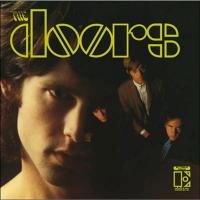The Doors At 45 On 45!
The album holds up incredibly well, which is why it's revered both by boomers and their children and their (gasp!) grandchildren. The raw power contained in Jim Morrison's voice, combined with uncommon precision still dominates but appreciating everyone else's contributions becomes easier with the passage of a lot of time and especially with the improvement in one's audio system (though I had AR2ax speakers, Dynaco Stereo 70/PAS 3x and Dual 1209/Shure V15 at the time, which wasn't shabby!)
I'm not going back to read the review of The Doors box set published on musicangle.com. It's there should you wish to read it, but after hearing these 45s, what's the point? I did listen last night and compare The Doors from the box set generated from 192k/24 bit files at 33 1/3 and this new double 45 cut by Doug Sax at The Mastering Lab and overseen by original engineer Bruce Botnick. You can also search this site for an interview conducted by me with Bruce when the DCC Compact Classics Doors titles were issued.
I listened first to the double 45 and even though it was cut from "the best available" tape because the master is either missing or not in any condition to be used (the rest of the catalog was sourced from the master tapes) the amount of detail and space produced here is superior to any version of this that I've heard save for the Elektra original, which is serious competition though good luck finding a clean quiet one. Even then the 45rpm cut's spaciousness, dynamics and bass power and particularly the overall sound on what are the inner tracks on the original LP are better on the double 45 cut using an all vacuum tube chain just as was the original.
The DCC doesn't hold up all that well by the way. It doesn't sound like it was cut from master tapes or even anything close to masters. It's pleasingly warm but lacks transient clarity, transparency and doesn't resolve low level detail all that well. Back then we were happy to have anything well done from analog tapes but now we have something much better. I also pulled out the original Mobile Fidelity reissue and while many Mo-fi's back then were criticized for being too bright, this one pressed on JVC "Supervinyl" is one of Mo-Fi's better reissues of that era, plus the tape was how many years younger?
But what really surprised me was the LP/LP comparisons between the Rhino box and this double 45. After playing the double 45 and really enjoying and appreciating John Densmore's drumming as never before, and hearing greater bass texture and extension (bass supposedly by the late keyboardist/bassist Larry Knechtel—check out the beginning of "20th Century Fox" for raw bass power) than I can recall every hearing from this record—not to mention a far more pronounced reverb backdrop—I brought out the Rhino box.
Whatever I wrote about that box then, now, by comparison, the best I can say for The Doors on that set is that it sounds like you're hearing the album played back on the best CD player ever. It's smoooooth, laid back and pleasant but totally lacks balls, grit, detail, spaciousness and raw emotional power. The entire presentation is flat against a wall set up between the speakers. The double 45 has greater dynamics, detail, spaciousness and appropriate grit—everything the smooooth 192k/24 bit sourced version lacks.
And this double 45 wasn't even sourced from the master tape so get ready for even better on subsequent releases. If you like this one, you're going to love the rest, which we'll get to ASAP.
Definitely on my recommended list and the Quality Record Pressings vinyl is superb.



